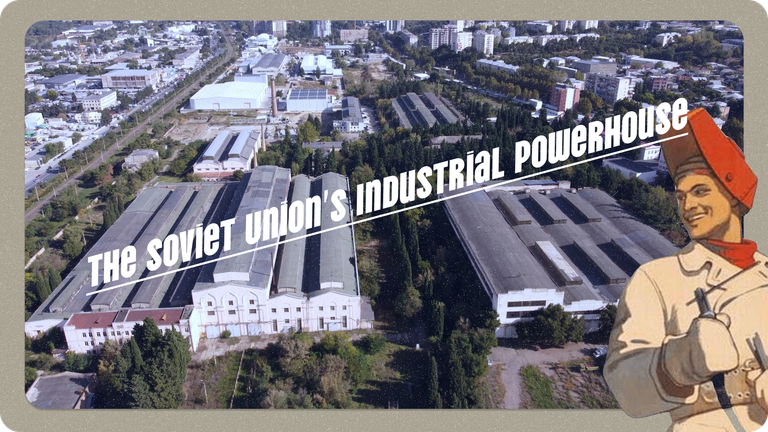
I had a few ideas for this post out of nowhere. There's a lot of urban exploration that I have been doing throughout Tbilisi, all the way down to hunting Tbilisi's secret nuclear bunkers that are hiding in plain sight. I've had some ideas for making posts about these in particular but the question of sharing locations of things people intentionally keep secret seems like a bad idea. But outside of these secret nuclear bunkers are their industrial zones that they reside in. The Soviet Union was terrified of the idea of a nuclear conflict with the United States of America. And that anxiety was much felt in these areas of high population and economic output. Railways, factories, and transportation routes were a high threat alongside your typical military zones. Tbilisi's industrial zones are scattered throughout the city, and are found tucked away in even the most dense and modern areas of the city. Some factories are turned into new hubs for culture and entertainment, whereas others are stripped out from the inside and turned into something not too different from their original intended purposes. Others, such as the ones featured in these images, have been left in time.
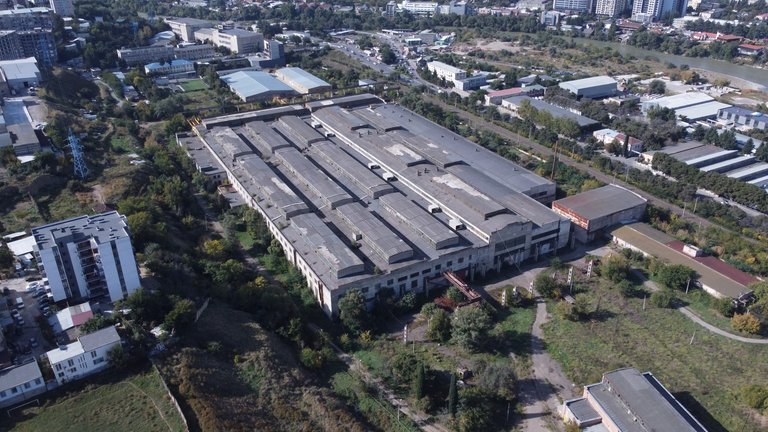
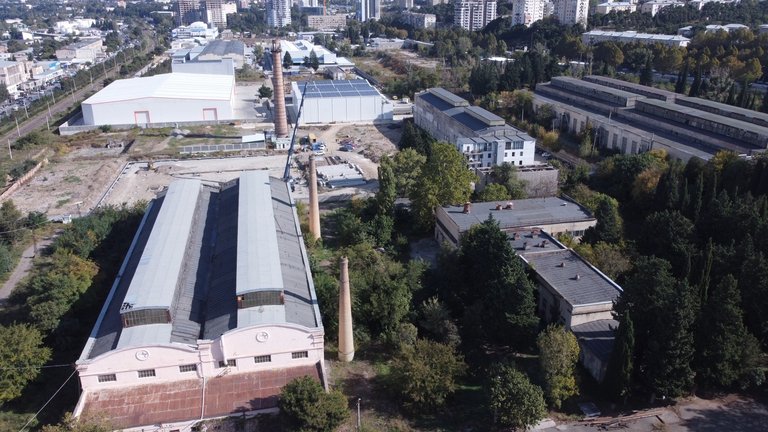
I spend a lot of time on Google Maps here. I'm always searching for something new to find and roam around on foot. These historical locations massively interest me for their architectural beauty and previous impact on the nations. Abandoned industrial zones are fascinating, they hold items of the past. They speak of an era long gone. And there's an atmosphere of greatness to them in this part of the world where their previous communist ideology held great pride in the idea of the worker and their freedom. Scattered throughout these rustic environments are symbols of the former Soviet Union. The red star at the top of buildings. Years of completion written proudly above warehouses. Or, if you're very lucky, you'll see the old hammer and sickle still present, though this is more of a rarity in the more central areas of Tbilisi, where the nation heavily rejected its past and has worked extensively to remove any communist symbols. I came across a specific area in the city that seemed massive. Huge buildings that just appeared out of nowhere in the heavily-developing areas of the city. Green all around as this area had been forgotten in time. It's generally quite rare to find large areas like this in the centre of the city, where decades of neglect had turned many of these zones into debris.

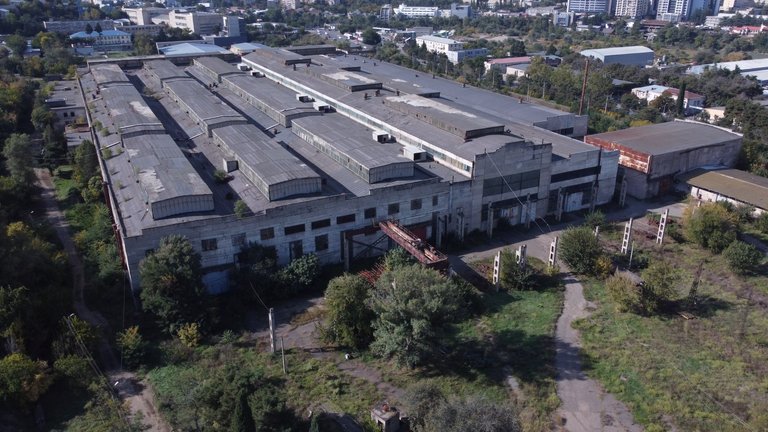
The thing that stood out to me here though was the clear preservation of these buildings. It felt untouched based on the images from the maps. I researched a route over to the location to which it took me out of the cozy area of residential Saburtalo and north of the city, taking the old Soviet metro lines that also heavily showed their age. A little bit of walking in the area and rechecking maps had me walking through old and decaying apartment buildings. Dogs barking wildly from balconies down at me, and the fear of there being stray dogs in this quiet area instantly hit. I was alone. The air was mostly still and the sun was still somewhat strong despite the clear arrival of autumn, and it led to a perfect environment for setting up my drone and throwing it up over the area to scout a bit. The first thing I wanted was to find entry points, and to check if there was a clear attempt to secure this zone before attempting to enter it. Though with that stray dogs concern, I photographed this zone from above only, with intent to return to the location for ground photographs inside another time. I was in awe at how large this area was. How immaculate its condition was. Yet it felt empty, abandoned and clearly forgotten in time. I was surprised at how the buildings weren't riddled in graffiti or with tons of smashed windows and scattered stolen pieces of metal.
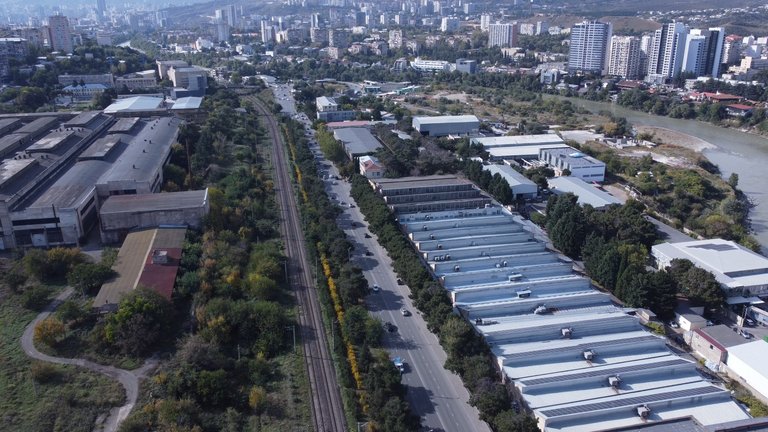
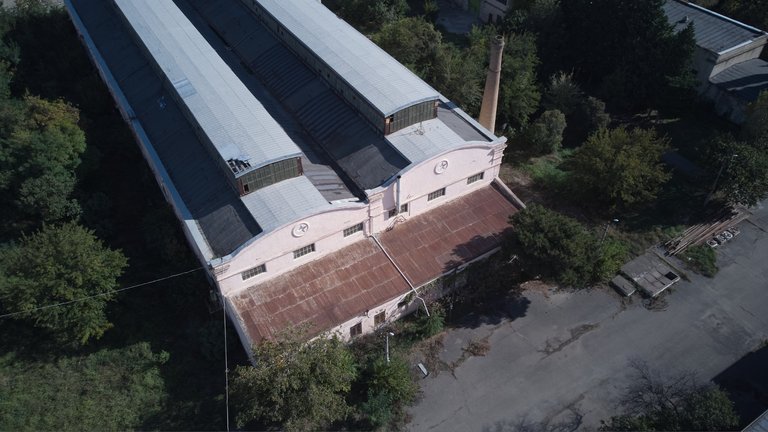
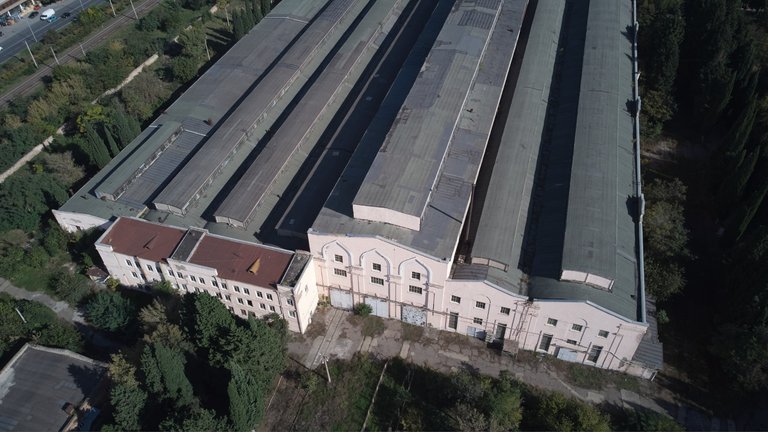
These factories appear out of nowhere with a drone, but are hidden from view with the density of trees around. Primarily hidden by a large wall and the aforementioned rail that connects to the main road. I think these two reasons in particular are what have led to these factories remaining in such incredible condition. Void of damage from vandals and generally graffiti free. I really liked seeing this from the drone, the immaculate condition of these buildings gives such a better view of what this place could've once looked like at its height. And it's somewhat visible with the bits and pieces of machinery and industry that remain. And that feeling of industrial might is felt with the presence of the red star itself in the image above, which reigns above one particular factory building. I didn't notice it or any other symbols similar to the Soviet Union here outside of this one. Which surprised me a little bit. Though I may have missed something. There are often signs of the pride in industry in such areas, whether it's the date of creation or communist symbolism. It really felt like a personal tour through time to fly the drone over the area.
These factories are also definitely containing original machinery and items too. The biggest sign was how the drone would lose its signal while flying lower to the rooftops. Where all that interior machinery would've resulted in the signal getting interference. The largest building in particular impacted the drone quite heavily as I flew low to the roof, shooting directly over it and then experienced total signal loss. I assumed the drone would've crashed into something had it continued to move forward given how low it was. But it stopped, gained more altitude and automatically attempted to return to home. I experimented a little with this by flying higher and around certain areas of the buildings, trying to see which ones would have something interesting to explore and photograph inside upon a second exploration to the area.
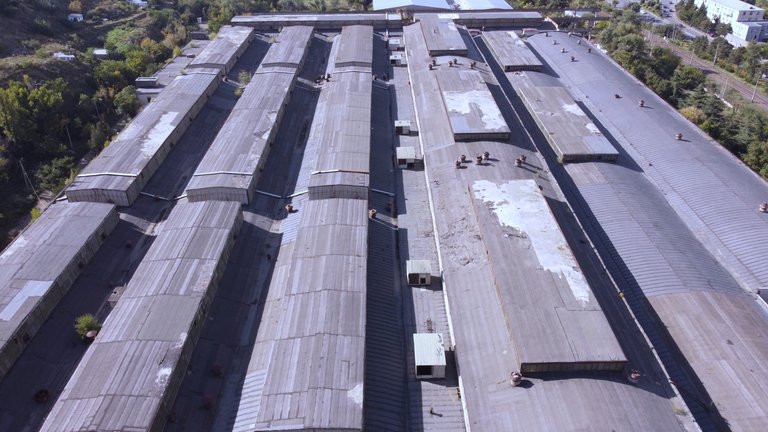
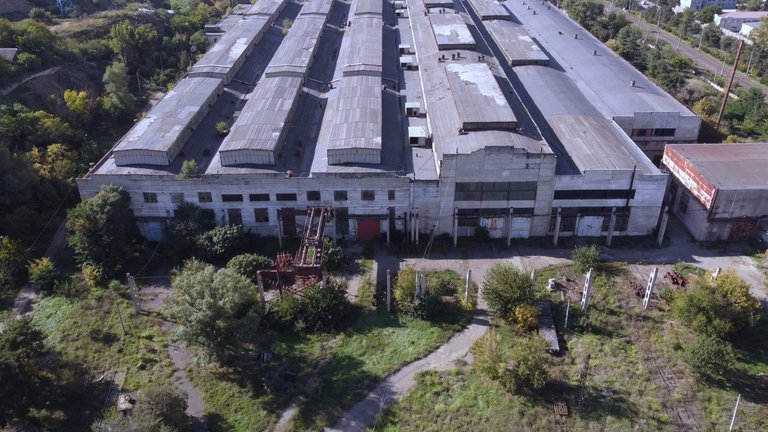
This is a similar view to what I had before the signal loss. Here things were fine. But the more interesting thing you can notice is how good the condition of the rooftops are. These larger buildings had rail that would go inside, with large doors that would open and close to accommodate the arrivals and departure of the factory's produce. I suspect that some of the Soviet symbolism was likely removed around the collapse of the Soviet Union and that some of these factories may have continued production for a few more years. That is often the case in certain areas where the factories have such a massive scale such as this one. The smaller ones in more remote areas being the ones to have suffered almost immediately given the difficulty of transportation and the little importance their production would've had domestically. These factories are in the heart of Tbilisi. Residential space is found all around, with the river not far from it. Though I don't want to be saying where exactly these factories are located as to ensure their general protection and condition going forward. Assuming the government doesn't have modern plans of total destruction of them; something I suspect would've happened already had these buildings not been so large and located in such a difficult space with the rail so close.
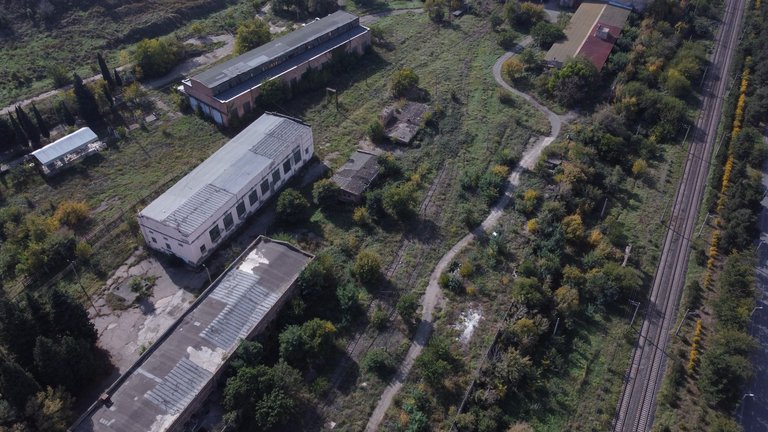
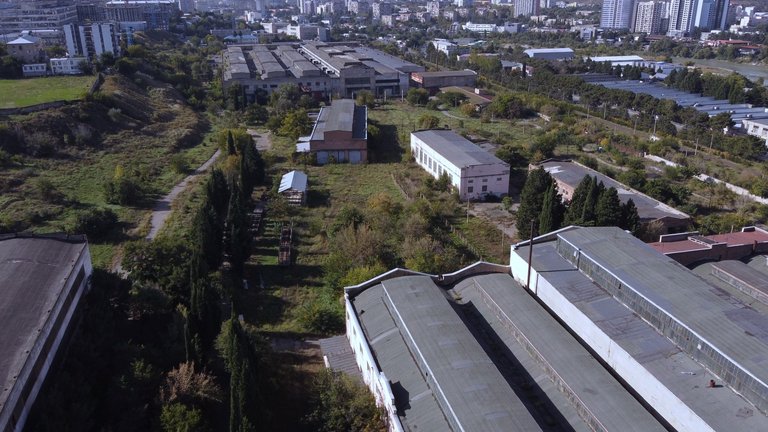
Here you can see the various buildings in the area that would've handled different production tasks. From offices that handle the paperwork side of things and overhead, to the worker's rooms where they would've kept their belongings and checked in and out each day. As well as had their moments of rest and food during the day. Others were clearly meant for the holding of goods for storage. Some buildings had larger towers by their sides which were used for the burning of material for the production side of things. I thought about it a little and based on their sizes and shape, they didn't have a purpose of cooling things, but rather were smoke towers. You can see these in the above images featured in the post. In some areas there were clear passages to underground areas. This was something I expected given the importance of the Soviet Union's industrial matters in the event of nuclear war with NATO. I'm not posting images of these suspected areas, but factories were often a point of interest for nuclear bunkers, where they'd often be found either inside the buildings or nearby. Perhaps something to feature in the future post where I approach this space on foot.
That said, this space displays the sheer scale and seriousness of the Soviet Union's ability to produce and sustain itself. Likely created around the 1950s as the industrial boom came about shortly after the Second World War and the Soviets recovered tremendously with a much stronger ideology that pursued modernism alongside the industrial powerhouse intent. If the Soviets were to survive against the race with the west, they had no choice but to create and produce. These buildings a sign of that Cold War era of anxiety. And that anxiety is something that fuelled significant changes around the world; something we shouldn't be demolishing and forgetting.
It's unfortunate such big buildings are abandoned like that. It could definitely handle big production and I am sure was thriving during its time. Imagine if those are alive again, it would create an interesting shift in today's geopolitical landscape.
Yeah the sheer scale of this area shows a time of very strong industrial strength. The collapse of the USSR and the following globalism definitely killed it off in most nations. It's a tragedy given how many people would've relied on the income to survive. As well as having some pride in the nation due to it actually being able to sustain itself.
I think there's a strong correlation between industrial scale and nation happiness (in most, not all) nations. In the west everyone associates the decline of their land with the collapse of industry, where nothing is made anymore and the patriotism is gone.
These locations could have been the perfect location for a modern James BOnd movie in which they hide all sorts of weapons inside these heavily guarded facilities, and if you add some tense music in the background, some bad-ass terrorists, and a nice new actor as James Bond... I would definitely go to the cinema again!
Yeah! I'm really curious about the interiors. I have no doubts they've been untouched for decades. The windows aren't smashed, there's nothing that looks as if it's been neglected and vandalised. It must have a lot of cool stuff inside.
The outside is something out of a zombie outbreak for sure. All overgrown and rustic.
Well, sounds like a perfect location for a movie to me! :)
Actually, it's funny you mention it. I just remembered that recently I was seeing a large uptick in film productions around the city in relatively old locations like factories. I'd see them setting up the lighting outside, all the vans parked up with gear. I was quite tempted to go and ask about it all. :^)
You are in the movie business, so I think you should definitely feel free to do so! By the way, are you just traveling the area, or have you moved permanently? Seem to remember that you are from the UK originally or something like that, but I might be wrong!
Yeah I'm from the UK. Last year I went to Istanbul for two weeks, I initially was meant to go home after that but instead went to Armenia, and then spent 8 months there. I took the train from there to Tbilisi so now I'm in Georgia and have been here for four months or so.
I haven't permanently moved, I do plan on going back to England at some point but probably not for a long time. I have been doing my own thing instead of what I used to do back in the film industry in England. Picking up photography work here and there while also shooting stock footage with my drone. Pretty fun!
Thank you for the answer! Wish you all the best and good luck no matter what you do and where in the world you do it! :)
It’s amazing to see that while it is deserted, the structures still look very much intact. Wonder if there is any special materials used for the construction to withstand all the weathering.
The things outside have clearly been there for decades and started to rust over. But I have no doubts that there's plenty of fun things inside in good condition. I do plan to do a little trip over there and find a way inside some of them to photograph. But Tbilisi is riddled with stray dogs and in such areas it's just really stupid to go alone.
It's also clear that very few people attempt to go there based on the lack of broken windows and graffiti. It definitely isn't easy to get to and looks incredibly difficult unless you go the route I did which still felt a bit risky with the strays. The drone signal cutting out over certain areas of the buildings is definitely a sign of some metals inside.
But the historical side really excites me. Even in the buildings that are more known and explored, there are still papers and posters from the Soviet Union inside, completely untouched. Something I like a lot about the urbex side of Tbilisi is that very historical areas are either very hard to get to and filter out the teenagers that wanna smash shit up, but are also kept secret from the general public. Nuclear bunkers are all over the city and hide in plain sight by the roads and in the sides of the rocky mountains, and explorers never share their locations; they also hold that rule of don't break or take.
I do wish some of these buildings had better care though. Some are incredibly beautiful with such unique designs to them.
Forgot to add: I think it really is just that these buildings have been left alone. There are a lot of them throughout the city that are still in use and it's just depressing to see the lack of care they've been given. Look up Nutsubidze Skybridge, or the Tbilisi State University Library. Both lived in and used, but look like they're ready to collapse at any moment.
Thank you for sharing even deeper. From the external, they look very sturdy especially when left alone without much care or maintenance.
I think most of the decay that's found around this part of the world in the buildings and roads really is just from neglect, rather than the materials or weathering over time. A problem may appear and it just gets ignored which naturally leads to greater decay. And that's found even within apartment buildings from the era. The one I am in, the stairway has huge chunks taken out of it to the point where you can see the rebar in the steps. Nothing is done about it though. The government clearly doesn't give a shit and the mentality of the people coming from a communist (and now fairly capitalist) era is that it's not their responsibility.
The same was in Armenia: old apartment buildings that tower into the sky that look ready to give in. Elevators from the Soviet Union still that wobble and barely function. But they'll happily fix the interiors of their own apartments and make those all spacious and modern. Step outside and the hallway has paint peeling off, missing windows in the stairways so it's cold all the time, etc. It's such a strange thing to see for me, knowing that back in England these things would've been dealt with ages ago.
I genuinely believe that one day these buildings will collapse with the people still in them, and even then nothing will be done to stop it from happening to the rest.
I see. Thanks for the further share. Then indeed it warrants additional eyes on it before anything catastrophic happens.
You can check out this post and your own profile on the map. Be part of the Worldmappin Community and join our Discord Channel to get in touch with other travelers, ask questions or just be updated on our latest features.
Congratulations, your post has been added to the TravelFeed Map! 🎉🥳🌴
Did you know you have your own profile map?
And every post has their own map too!
Want to have your post on the map too?
- Go to TravelFeed Map
- Click the create pin button
- Drag the marker to where your post should be. Zoom in if needed or use the search bar (top right).
- Copy and paste the generated code in your post (any Hive frontend)
- Or login with Hive Keychain or Hivesigner and click "create post" to post to Hive directly from TravelFeed
- Congrats, your post is now on the map!
PS: You can import your previous Pinmapple posts to the TravelFeed map.Opt Out
Congratulations @namiks! You received the biggest smile and some love from TravelFeed! Keep up the amazing blog. 😍 Your post was also chosen as top pick of the day and is now featured on the TravelFeed front page.
Thanks for using TravelFeed!
@for91days (TravelFeed team)
PS: Why not share your blog posts to your family and friends with the convenient sharing buttons on TravelFeed?
Fascinatingly, this really makes me think about how much more structurally firm most old buildings are, their durability just seems unmatched compared to modern architecture.
@namiks, I paid out 1.969 HIVE and 0.472 HBD to reward 6 comments in this discussion thread.